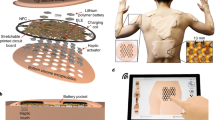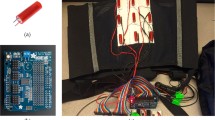Abstract
This paper describes an approach to design tactile haptic signals that help humans “visualize” an environment through the use of a vibrotactile haptic wristband that has four vibration motors. A human response map to tactile input while sitting was determined experimentally. It shows the zones where humans can classify signals with a high success rate based on minimum Duration of Stimulus (DOS) (“on” periods) and “off” periods of the haptic signals. It was also shown experimentally that a human’s ability to recognize tactile patterns depends on the level of engagement required by the activity. This paper provides an approach to predict a human response map for various activities. The map during sitting is used to design the signals to send information to a human. Two types of signals are developed: sequence stimuli and digital codes. Sequence stimuli create an on/off rhythm for the vibration motors that humans can sense directly without a decoding process. Experiments show that humans can recognize 10 levels of sequence stimuli with a success rate greater than 80%. This class of signals is useful for applications where information must be repeated frequently, e.g., range information sent to a human parking a car. The second class of signals is digital codes, similar to Morse code, where a sequence of long and short motor DOS represents each code. The meaning of the signal is associated with a specific code. From 27 digital codes, experiments showed a successful recognition rate of 78.7%. An application for the digital code method is to pick specific menu items, based on the codes, for fast food restaurants.











Similar content being viewed by others
References
Akita J, Ono T, Ito K, Okamoto M (2014) Touch at a distance: simple perception aid device with user’s explorer action. In: SIGGRAPH Asia 2014 Emerging Technologies. ACM
Bosman S, Groenendaal B, Findlater JW, Visser T, de Graaf M, Markopoulos P (2003) Gentleguide: an exploration of haptic output for indoors pedestrian guidance, human computer interaction with mobile devices and services. Springer, Berlin, pp 358–362
Brewster S, Brown LM (2004) Tactons: structured tactile messages for non-visual information display. In: Proceedings of the fifth conference on Australasian user interface, vol 28. Australian Computer Society, Inc., pp 15–23
Chantranuwathana S, Sornumpol P (2005) One-DOF arm movement guidance using vibrotactile feedback. In: The 19th conference of mechanical engineering network of thailand, Phuket, Thailand
Guo W, Wei N, Chen I-M, Ding ZQ, Yeo SH (2009) Intuitive vibro-tactile feedback for human body movement guidance. In: Proceeding of the 2009 IEEE international conference on robotics and biomimetics, Guilin, China, pp 135–140
Guyot GW, Johnson FD, Weaver C (1982) Two-point tactual discrimination on the back: a signal-detection approach. Percept Mot Skills 54(3c):1289–1290
Kohli L, Niwa M, Noma H, Susami K, Yanagida Y, Lindeman R W, Kume Y (2006) Towards effective information display using vibrotactile apparent motion. In: Haptic interfaces for virtual environment and teleoperator systems, 2006 14th Symposium on IEEE, pp 445–451
Lieberman J, Breazeal C (2007) TIKL: development of a wearable vibrotactile feedback suit for improved human motor learning. IEEE Trans Robot 23(5):919–926
Lindeman RW, Yanagida Y, Noma H, Hosaka K (2006) Wearable vibrotactile systems for virtual contact and information display. Virtual Real 9(2):203–213
Matscheko M, Ferscha A, Riener A, Lehner M (2010) Tactor placement in wrist worn wearables, wearable computer (ISWC). In: 2010 International Symposium on IEEE, pp 1–8
McDaniel T, Krishna S, Colbry D, Panchanathan S (2009) Using tactile rhythm to convey interpersonal distances to individuals who are blind. Im: CHI 2009, Boston, MA, USA, pp 4669–4674
Phanomchoeng G, Rajamani R, Hourdos J (2010) Directional sound for long distance auditory warnings from a highway construction work zone. IEEE Trans Veh Technol 59(5):2266–2276
Poupyrev I, Maruyama S, Rekimoto J (2002) Ambient touch: designing tactile interfaces for handheld devices. ACM, New York, pp 51–60
Poupyrev I, Okabe M, Maruyama S (2004) Haptic feedback for pen computing: directions and strategies. ACM, New York, pp 1309–1312
Rattanachotithavorn S, Sae-Ong P, Wannasuphoprasit W (2011) Experimental study of tactile stimulating system in back area for warning purpose. In: The 5th conference of TRS conference on robotics and industrial technology, Bangkok, Thailand
Scheggi S, Morbidi F, Prattichizzo D (2014) Human-robot formation control via visual and vibrotactile haptic feedback. IEEE Trans Haptics 7(4):499–511
Sergi F, Accoto D, Compolo D, Guglielmelli E (2008) Forearm orientation guidance with a vibrotactile feedback bracelet: on the directionality of tactile motor communication. In: Proceedings of the 2nd Biennial IEEE/RAS-EMBS international conference on biomedical robotics and biomechatronics, Scottsdale, AZ, USA, pp 433–438
Stanley AA, Kuchenbecker KJ (2012) Evaluation of tactile feedback methods for wrist rotation guidance. IEEE Trans Haptics 5(3):240–251
Szymczak D, Magnusson C, Rassmus-Grohn K (2012) Guiding tourists through haptic interaction: vibration feedback in the lund time machine. In: Isokoski P, Springare J (eds) EuroHaptics 2012, Part II. LNCS, vol 7283, pp 157–162
Tan HZ, Srinivasan MA, Eberman B, Cheng B (1994) Human factors for the design of force-reflecting haptic interfaces. Dyn Syst Control 55(1):353–359
Tsukada K, Yasumura M (2004) Activebelt: belt-type wearable tactile display for directional navigation. In: International conference on ubiquitous computing. Lecture notes in computer science, vol 3205. Springer, Heidelberg, pp 384–399.
van Erp JBF (2001) Tactile navigation display, haptic human–computer interaction. Lecture notes in computer science, vol 2058, pp 165–173
van Erp JBF (2002) Guideline for the use of vibro-tactile displays in human computer interaction. In: Proceedings of Eurohaptics, pp 18–22
van Erp JBF, van Veen HAHC (2004) Vibrotactile in-vehicle navigation system. Transp Res Part F: Traffic Psychol Behav 7(4):247–256. doi:10.1016/j.trf.2004.09.003
van Erp JBF, van Veen HAHC, Jansen C (2005) Waypoint navigation with a vibrotactile waist belt. ACM Trans Appl Percept 2(2):106–117
Yang U, Jang Y, Kim GJ (2002) Designing a vibro-tactile wear for close range interaction for vr-based motion training. In: International conference on artificial reality and telexistence, pp 4–9
Yano H, Miyamoto Y, Iwata H (2009) Haptic interface for perceiving remote object using a laser range finder. In: EuroHaptics conference, 2009 and symposium on haptic interfaces for virtual environment and teleoperator systems. World Haptics 2009. Third Joint IEEE, pp 196–201. IEEE
Acknowledgements
This paper was supported by the Chulalongkorn University Strategic Research Grant CU-57-074-AS.
Author information
Authors and Affiliations
Corresponding author
Rights and permissions
About this article
Cite this article
Phanomchoeng, G., Chancharoen, R. & Lumia, R. Developing vibrotactile haptic stimuli based on measured human capabilities. Virtual Reality 21, 203–212 (2017). https://doi.org/10.1007/s10055-017-0309-0
Received:
Accepted:
Published:
Issue Date:
DOI: https://doi.org/10.1007/s10055-017-0309-0




